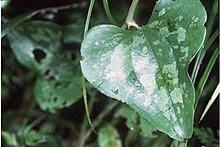Smilax bona-nox
| Smilax bona-nox | |
|---|---|

| |
| Scientific classification | |
| Kingdom: | Plantae |
| Clade: | Tracheophytes |
| Clade: | Angiosperms |
| Clade: | Monocots |
| Order: | Liliales |
| Family: | Smilacaceae |
| Genus: | Smilax |
| Species: | S. bona-nox
|
| Binomial name | |
| Smilax bona-nox | |
| Synonyms[1] | |
|
Synonymy
| |
Smilax bona-nox, known by the common names saw greenbrier,[2] zarzaparrilla,[3] catbrier, bullbrier, chinabrier, and tramp's trouble,[4] is a species of flowering plant in the Smilacaceae, or greenbrier family. The species is native to the southeastern United States from Delaware to Florida and as far west as Kansas and Texas, as well as Bermuda and much of Mexico.[4][5][6][7]
This plant is a rhizomatous vine with climbing, branching stems that grow up to 8 meters long. Many of the branches are covered in prickles up to 9 millimeters long. The evergreen leaves are pale green, sometimes with white blotches, and are variable in shape. The inflorescence is an umbel of up to 15 or more pale green flowers. The fruit is a black berry[3] just under a centimeter in length. It contains one seed. The plant reproduces by seed and by sprouting from its rhizome.[4]
This plant grows in many types of habitat alongside plants such as muscadine grape (Vitis rotundifolia), Virginia creeper (Parthenocissus quinquefolia), trumpetcreeper (Campsis radicans), peppervine (Ampelopsis arborea), Alabama supplejack (Berchemia scandens), and eastern poison-ivy (Toxicodendron radicans). It easily grows in disturbed habitat,[4] and can become weedy.[3]
The fruits of this plant provide food for many species of animals, including many birds. The dense, prickly thickets make good cover for small animals.[4]
Native Americans found several uses for the plant. The Muscogee people (also known as the Creek people) rubbed the moistened plant on their faces to enhance youthfulness, and the Comanche people used the leaves for cigarette wrappers.[8] The Houma people of Louisiana used Smilax bona-nox roots to treat urinary tract infections and to make bread and cake.[8]
References
- ^ Kew World Checklist of Selected Plant Families
- ^ USDA, NRCS (n.d.). "Smilax bona-nox". The PLANTS Database (plants.usda.gov). Greensboro, North Carolina: National Plant Data Team. Retrieved 16 November 2015.
- ^ a b c Smilax bona-nox. Flora of North America.
- ^ a b c d e Sullivan, Janet. 1994. Smilax bona-nox. In: Fire Effects Information System, [Online]. U.S. Department of Agriculture, Forest Service, Rocky Mountain Research Station, Fire Sciences Laboratory.
- ^ Biota of North America Program 2014 county distribution map
- ^ Huft, M. J. 1994. 243. Smilacaceae. 6: 20–25. In G. Davidse, M. Sousa Sánchez & A.O. Chater (eds.) Flora Mesoamericana. Universidad Nacional Autónoma de México, México, D.F.
- ^ Killip, E. P. & C. V. Morton. 1936. Botany of the Maya Area: miscellaneous papers XII. A revision of the Mexican and Central American species of Smilax. Publ. Carnegie Inst. Wash. 461(12): 255–298,, t. 1–11.
- ^ a b "Search for Smilax bona-nox found 6 matches". University of Michigan–Dearborn. 2012-02-07. Archived from the original on 2012-02-07. Retrieved 2012-02-08.
{{cite web}}: Cite has empty unknown parameter:|coauthors=(help)

